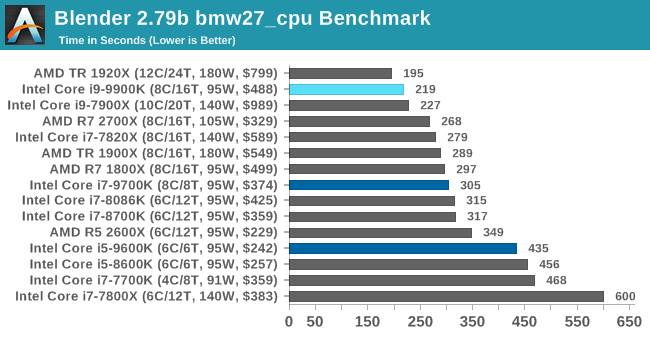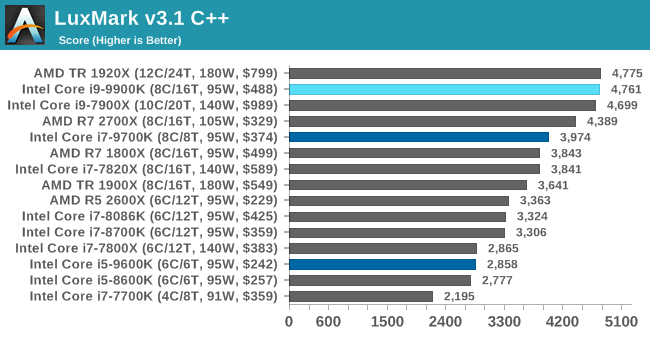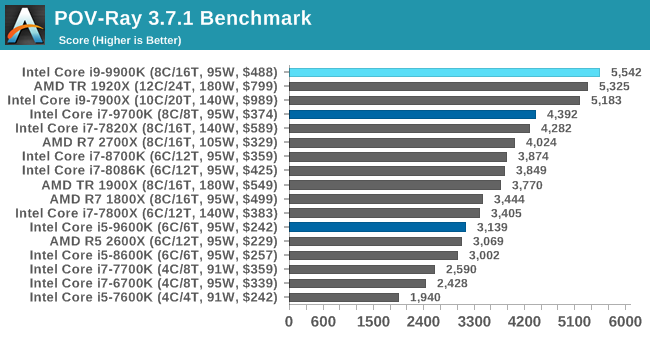The Intel 9th Gen Review: Core i9-9900K, Core i7-9700K and Core i5-9600K Tested
by Ian Cutress on October 19, 2018 9:00 AM EST- Posted in
- CPUs
- Intel
- Coffee Lake
- 14++
- Core 9th Gen
- Core-S
- i9-9900K
- i7-9700K
- i5-9600K
CPU Performance: Rendering Tests
Rendering is often a key target for processor workloads, lending itself to a professional environment. It comes in different formats as well, from 3D rendering through rasterization, such as games, or by ray tracing, and invokes the ability of the software to manage meshes, textures, collisions, aliasing, physics (in animations), and discarding unnecessary work. Most renderers offer CPU code paths, while a few use GPUs and select environments use FPGAs or dedicated ASICs. For big studios however, CPUs are still the hardware of choice.
All of our benchmark results can also be found in our benchmark engine, Bench.
Corona 1.3: Performance Render
An advanced performance based renderer for software such as 3ds Max and Cinema 4D, the Corona benchmark renders a generated scene as a standard under its 1.3 software version. Normally the GUI implementation of the benchmark shows the scene being built, and allows the user to upload the result as a ‘time to complete’.
We got in contact with the developer who gave us a command line version of the benchmark that does a direct output of results. Rather than reporting time, we report the average number of rays per second across six runs, as the performance scaling of a result per unit time is typically visually easier to understand.
The Corona benchmark website can be found at https://corona-renderer.com/benchmark

Corona is a fully multithreaded test, so the non-HT parts get a little behind here. The Core i9-9900K blasts through the AMD 8-core parts with a 25% margin, and taps on the door of the 12-core Threadripper.
Blender 2.79b: 3D Creation Suite
A high profile rendering tool, Blender is open-source allowing for massive amounts of configurability, and is used by a number of high-profile animation studios worldwide. The organization recently released a Blender benchmark package, a couple of weeks after we had narrowed our Blender test for our new suite, however their test can take over an hour. For our results, we run one of the sub-tests in that suite through the command line - a standard ‘bmw27’ scene in CPU only mode, and measure the time to complete the render.
Blender can be downloaded at https://www.blender.org/download/

Blender has an eclectic mix of requirements, from memory bandwidth to raw performance, but like Corona the processors without HT get a bit behind here. The high frequency of the 9900K pushes it above the 10C Skylake-X part, and AMD's 2700X, but behind the 1920X.
LuxMark v3.1: LuxRender via Different Code Paths
As stated at the top, there are many different ways to process rendering data: CPU, GPU, Accelerator, and others. On top of that, there are many frameworks and APIs in which to program, depending on how the software will be used. LuxMark, a benchmark developed using the LuxRender engine, offers several different scenes and APIs.

Taken from the Linux Version of LuxMark
In our test, we run the simple ‘Ball’ scene on both the C++ and OpenCL code paths, but in CPU mode. This scene starts with a rough render and slowly improves the quality over two minutes, giving a final result in what is essentially an average ‘kilorays per second’.


POV-Ray 3.7.1: Ray Tracing
The Persistence of Vision ray tracing engine is another well-known benchmarking tool, which was in a state of relative hibernation until AMD released its Zen processors, to which suddenly both Intel and AMD were submitting code to the main branch of the open source project. For our test, we use the built-in benchmark for all-cores, called from the command line.
POV-Ray can be downloaded from http://www.povray.org/












274 Comments
View All Comments
AutomaticTaco - Saturday, October 20, 2018 - link
Revised. TDP is still some generic average not true max. Regardless, not 220w.https://www.anandtech.com/show/13400/intel-9th-gen...
The motherboard in question was using an insane 1.47v
https://twitter.com/IanCutress/status/105342741705...
https://twitter.com/IanCutress/status/105339755111...
AGS3 - Friday, October 19, 2018 - link
Can't wait to get one - thanks. I may have missed it but what cooler did you use for overclock?5080 - Friday, October 19, 2018 - link
To summarize Intel's new i9-9900K = Incredible high power usage and heat generation at a high price with no real advantage = market fail.AutomaticTaco - Saturday, October 20, 2018 - link
Revised power consumption. First motherboard was over-voltage.https://www.anandtech.com/show/13400/intel-9th-gen...
SaturnusDK - Sunday, October 21, 2018 - link
Doesn't change the above conclusion of the intel "FX" 9000-series.hnlog - Friday, October 19, 2018 - link
Why TRUE Copper is chosen for Intel new CPUs and HEDT?shabby - Friday, October 19, 2018 - link
Ya I wonder if the 9900k will hit 4.7ghz on all cores with a stockish heatsink, it almost seems like Intel is cheating here, 200+ watts on a 95w cpu. I have a feeling amd will follow suit in the next round by letting the turbo mode suck as much juice as possible.Spoelie - Friday, October 19, 2018 - link
Seconded, can we see what the processors will do with the same cooling capacity provided?ThaSpacePope - Friday, October 19, 2018 - link
Looks like i'm keeping my i7-9700k pre-order for $399. In 2012 I paid $190ish (in 2012 dollars) for my i5-3570k which is 4 cores running at 4.5ghz for 6 years now. In 2018 today I'll pay $399 for 8 cores running at 5.3ghz (it appears) and a roughly 40% IPC improvement. Feels like a good value, thank you AMD. Anyone recommend a good Z390 board to go along with it?mapesdhs - Sunday, October 21, 2018 - link
Thank you AMD? This is why AMD has given up on high end GPUs.